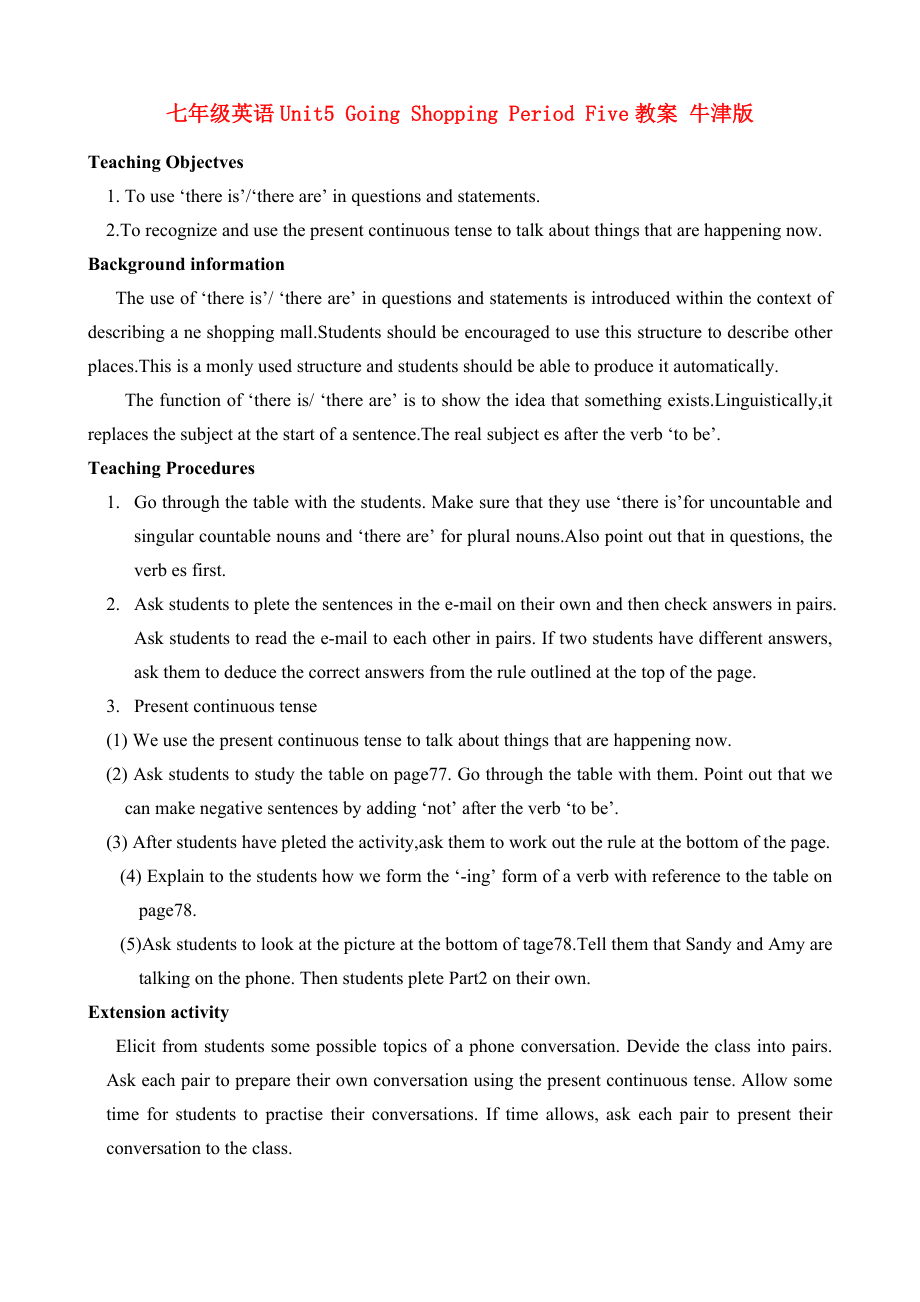《七年級(jí)英語(yǔ)Unit5 Going Shopping Period Five教案 牛津版》由會(huì)員分享�����,可在線閱讀�,更多相關(guān)《七年級(jí)英語(yǔ)Unit5 Going Shopping Period Five教案 牛津版(2頁(yè)珍藏版)》請(qǐng)?jiān)谘b配圖網(wǎng)上搜索����。
1、七年級(jí)英語(yǔ)Unit5 Going Shopping Period Five教案 牛津版
Teaching Objectves
1. To use ‘there is’/‘there are’ in questions and statements.
2.To recognize and use the present continuous tense to talk about things that are happening now.
Background information
The use of ‘there is’/ ‘there are’ in questions
2����、 and statements is introduced within the context of describing a ne shopping mall.Students should be encouraged to use this structure to describe other places.This is a monly used structure and students should be able to produce it automatically.
The function of ‘there is/ ‘there are’ is to show th
3、e idea that something exists.Linguistically,it replaces the subject at the start of a sentence.The real subject es after the verb ‘to be’.
Teaching Procedures
1. Go through the table with the students. Make sure that they use ‘there is’for uncountable and singular countable nouns and ‘there are’ f
4�、or plural nouns.Also point out that in questions, the verb es first.
2. Ask students to plete the sentences in the e-mail on their own and then check answers in pairs. Ask students to read the e-mail to each other in pairs. If two students have different answers, ask them to deduce the correct answ
5、ers from the rule outlined at the top of the page.
3. Present continuous tense
(1) We use the present continuous tense to talk about things that are happening now.
(2) Ask students to study the table on page77. Go through the table with them. Point out that we can make negative sentences by addin
6����、g ‘not’ after the verb ‘to be’.
(3) After students have pleted the activity,ask them to work out the rule at the bottom of the page.
(4) Explain to the students how we form the ‘-ing’ form of a verb with reference to the table on page78.
(5)Ask students to look at the picture at the bottom of t
7、age78.Tell them that Sandy and Amy are talking on the phone. Then students plete Part2 on their own.
Extension activity
Elicit from students some possible topics of a phone conversation. Devide the class into pairs. Ask each pair to prepare their own conversation using the present continuous te
8�、nse. Allow some time for students to practise their conversations. If time allows, ask each pair to present their conversation to the class.
Exercises
A 把下列改為一般疑問(wèn)句,否定句和特殊疑問(wèn)句�����。
1. There is some milk in the glass.
2. There are some people in the playground.
3. There is a book on my table.
4. Th
9����、ere are three small shops near our school.
5. There is a lot of food in my house..
B. Fill in the blanks with the words given.
1. _______ they_______(play) basketball on the playground now.
Yes ,we ________.
2. Look, the children _________(swim) in the lake.
3. Listen, who _________(read) English in the next room.
4. What ______you _______(do)? I _________(do) my homework.
5. Sandy __________(not play) games now. She ________(study) Maths.
6. Daniel ________(wait) for the bus at the school gate now.
 七年級(jí)英語(yǔ)Unit5 Going Shopping Period Five教案 牛津版
七年級(jí)英語(yǔ)Unit5 Going Shopping Period Five教案 牛津版

